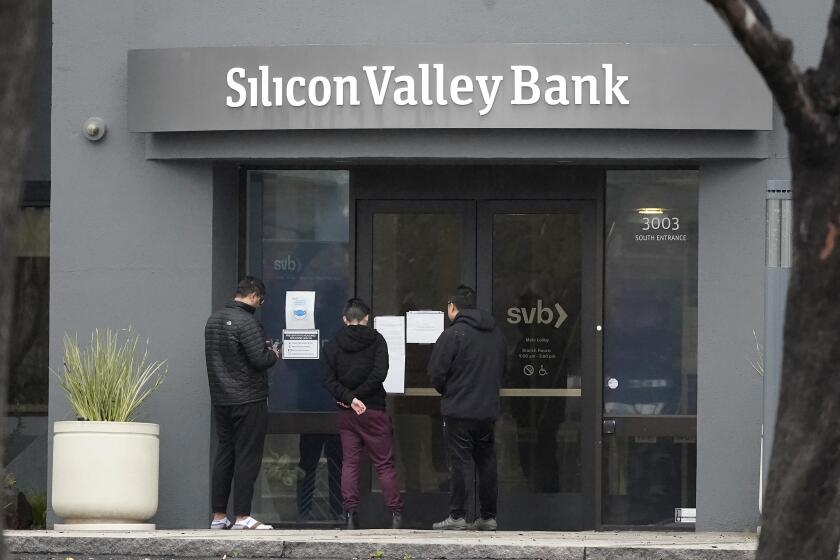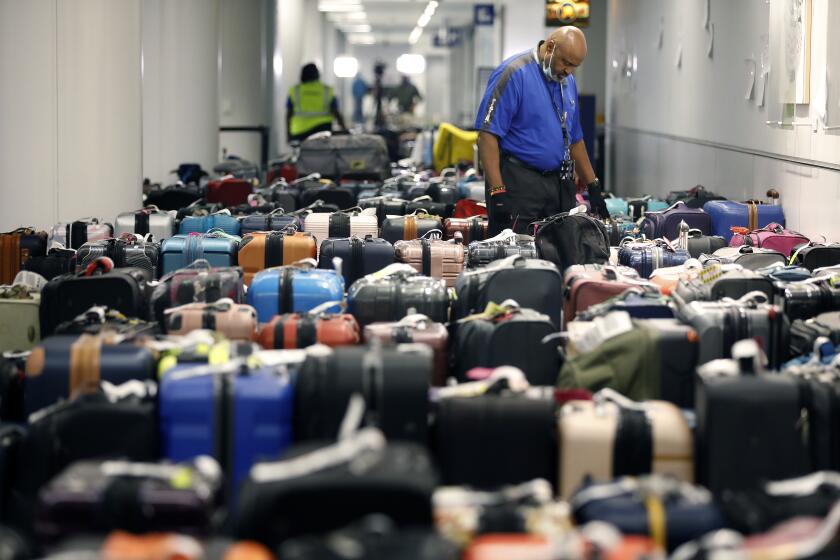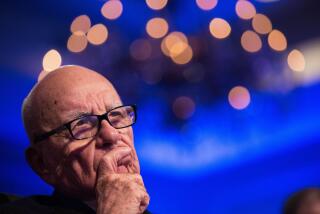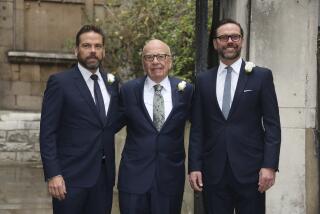Column: What ‘Succession’ got wrong about what happens when moguls die
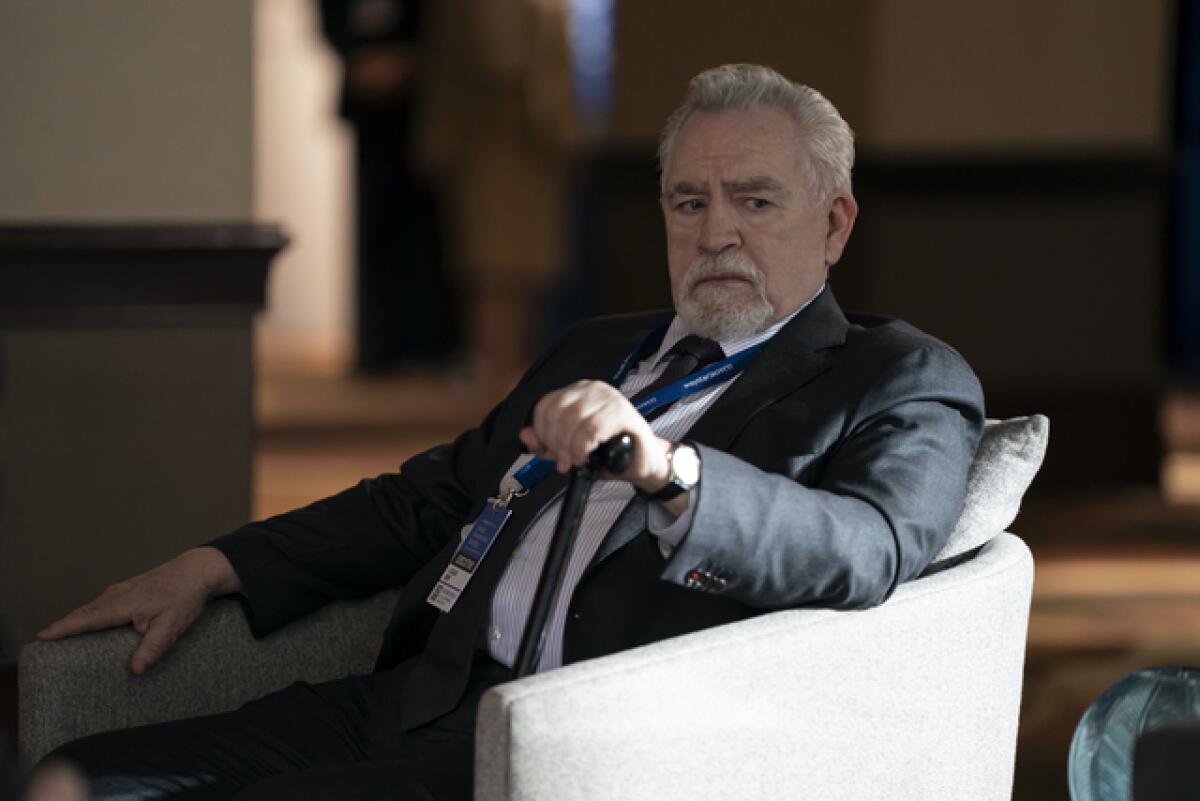
- Share via
Near the very end of Sunday’s episode of HBO’s hit show “Succession,” Roman Roy shows his siblings a stock price chart on his smartphone.
The image indicates that the shares of Waystar Royco, their family-controlled corporation, are falling off a cliff thanks to the announcement of the death of the company patriarch, Logan Roy.
“There he is,” Roman says, measuring the breadth of the decline between thumb and forefinger. “That is Dad.”
The fictional moment communicates how crucial Logan Roy’s role had been to the company’s success. It’s not, however, supported by history.
Demands by the tech industry’s most vocal libertarians for a government bailout of Silicon Valley call to mind the old saw: The goal in business to privatize profits and socialize losses.
In real life, the death of hyper-controlling business moguls often turns into occasions to reassess their handiwork. The assessments are not always positive.
Let’s examine what may be the closest real-life analogue to the death of Logan Roy. That’s the death of Charles Bluhdorn, the creator and undisputed king of the conglomerate Gulf & Western Industries, in 1983.
‘There he is. That is Dad.’
— Roman Roy, in a scene from HBO’s show ‘Succession’
Bluhdorn, like Logan Roy, died one Saturday onboard an airplane in flight, leaving a sizable time span between the event and its public disclosure. Something of a corporate urban legend has it that company executives traveling with Bluhdorn scurried to tell their brokers to sell their shares before his death became known, figuring to get ahead of the stock price carnage that would occur as soon as Bluhdorn’s death was announced — the Logan Roy effect.
Instead, Gulf & Western shares rose, gaining $2.25, or 12.5%, on their first trading day after the announcement and nearly 40% during that week.
What happened?
Get the latest from Michael Hiltzik
Commentary on economics and more from a Pulitzer Prize winner.
You may occasionally receive promotional content from the Los Angeles Times.
Gulf & Western had been a pillar of the conglomerate school of corporate empire-making. The Vienna-born Bluhdorn had built it by accretion, starting with Michigan Plating and Stamping, an auto parts company, in 1956. At the time of his death, the company owned Paramount Pictures, Simon & Schuster, the Consolidated Cigar Co, the Sega video game company, two racetracks, a Puerto Rican sugar plantation, a zinc smelter, and $800 million in shares of 30 unrelated public companies.
Investors’ faith in conglomerates had already begun to fade. Gulf & Western was seen as the model of the non-strategic acquirer — few of its holdings, if any, had any synergistic relationship to the others, but seemed to have been bought on a whim; Mel Brooks lampooned the company in his film “Silent Movie” as “Engulf & Devour.”
Bluhdorn epitomized the hands-on corporate mogul. It was understood that he was the sole decision-maker about what could be sold from Gulf & Western’s portfolio. On Wall Street, the perception also had grown that the parts of Gulf & Western were more valuable than the whole.
With Bluhdorn out of the picture, the breakup could begin. In the first week of the post-Bluhdorn era, corporate raiders Carl Icahn, Ivan Boesky and Carl Lindner were reported to have taken large stakes in Gulf & Western.
Bluhdorn’s successor as CEO, Martin S. Davis, promptly started to dismantle the edifice. He stripped away Gulf & Western’s weirder ancillary holdings, including Consolidated Cigar and casket- and cement-makers.
By 1989, The Times reported, Davis had “reshaped Gulf & Western from a ragtag agglutination of about 100 businesses to a thriving corporation focused in entertainment, publishing and finance.” By then, the stock had risen six-fold from its level at Bluhdorn’s death. Its crown jewels were Paramount, the most valuable studio in Hollywood, and Simon & Schuster, the nation’s largest book publisher.
The company would undergo several further transformations in ensuing years through mergers and acquisitions including CBS and Viacom. Its remains are today consolidated as Paramount Global, which still encompasses CBS, the Paramount studio and Simon & Schuster, among other holdings chiefly in entertainment.
Of course, not every mogul-led corporation will follow the same trajectory as Gulf & Western. Indeed, judging from previews aired after Sunday’s “Succession” episode, it’s possible that the show’s writers have absorbed the lessons of history.
Despite pandemic closures and more shareholder votes against their pay, CEO compensation keeps soaring. But there are signs the backlash is working.
Like Gulf & Western, the fictional Waystar Royco is less than universally admired by investors and perceived to be more valuable broken up than kept together. How that works out will unfold through the rest of the series’ final season.
When it comes to the fortunes of a corporation after the loss of a leader, much depends on how much control the leader actually exercises and his or her reputation for sagacity and managerial skill.
CEO reputations can be volatile. When Jack Welch retired as chairman and CEO of General Electric in 2001, he was hailed as a titan of industry and GE reigned as one of the nation’s most successful corporations.
Soon after that, however, the flaws in Welch’s record emerged. GE’s spectacular growth during his tenure was largely fueled by GE Capital, the finance arm he nurtured, which became a drag on performance after his retirement.
GE, which in 2008 was the only remaining component of the Dow Jones industrial average from the index’s creation in 1896, was thrown off the index that year in favor of Walgreens Boots Alliance. In 2021, the company announced that it would split into three smaller companies, a process that will take until 2024.
The reputations of contemporary moguls are works in progress. The close identification of business leaders with their companies can be a mixed curse. A year ago, it might have been an article of faith that the electric vehicle maker Tesla couldn’t survive without Elon Musk. But Musk’s multiple missteps as owner of Twitter have obliterated his stature as a business genius, even as the automaker faces mounting challenges in the electric vehicle market from legacy manufacturers moving into the new technology.
The same may be said of Mark Zuckerberg, the undisputed boss of Meta platforms, formerly Facebook. Zuckerberg exercises even more authority over his company than Musk does over Tesla, for unlike Musk, he holds an unassailable majority of its stock voting rights.
Yet in the last year or more Zuckerberg has seemed to be flailing in his search for the next big driver of Meta’s growth, swinging from the notion of a metaverse, a virtual world over which Meta would reign and on which it would spend billions of dollars, to video and artificial intelligence.
Southwest executives have issued public apologies and its front-line workers have taken the brunt of customer fury, but the board of directors is missing in action
The quintessential Logan Roy figure on the scene today is Rupert Murdoch, 92, who exercises authority over News Corp., the owner of the Wall Street Journal, HarperCollins and other media properties, and Fox Corp., which owns Fox News, Fox Sports and Fox television stations among other properties.
Fox News, however, is under legal attack by two voting machine companies because of its retailing of thoroughly debunked claims about their role in supposedly fraudulent results in the 2020 presidential election.
Whether Tesla, Meta or the Murdoch companies would suffer or thrive from the departure of their leaders is hard to say just now. Of those, only Fox and News Corp. appear to have succession arrangements in place, with Murdoch’s son Lachlan positioned to take over after his father’s death. (“Succession” was adapted from a screenplay its creator, Jesse Armstrong, wrote about the Murdoch family but never got made.)
“Succession” will undoubtedly provide us with weeks of entertaining glimpses into how the heirs of a micromanaging patriarch try to keep their legacy, and themselves, together. But real life may yet provide us with some very similar spectacles.
More to Read
Get the latest from Michael Hiltzik
Commentary on economics and more from a Pulitzer Prize winner.
You may occasionally receive promotional content from the Los Angeles Times.

